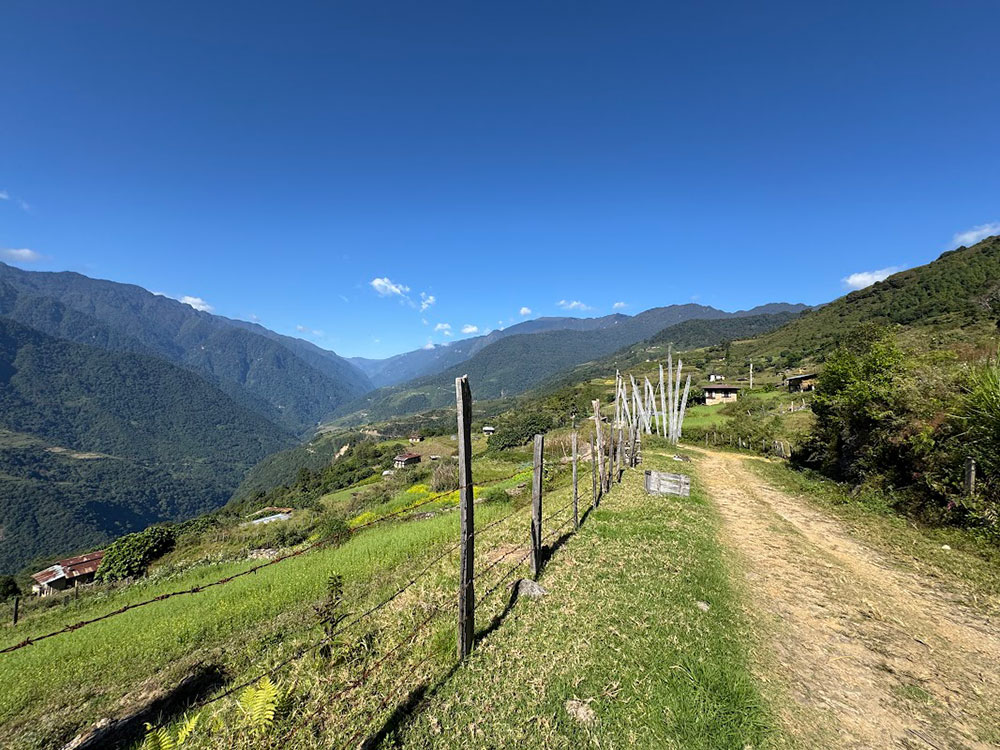The struggle to balance conservation and livelihood in remote villages of Zhemgang continues
Lhakpa Quendren
Zhemgang—In the remote village of Thrisa in Shingkhar gewog of Zhemgang, a seven-kilometre stretch of chain-link fence has proven to be a vital line of defence against one of the most recurring challenges confronting the district—human-wildlife conflict (HWC).
For the past two years, a lone tiger has been spotted prowling on the fringes of Phrumsengla National Park and repeatedly venturing into the villages to prey on cattle.
Thrisa, home to 50 households, has long been vulnerable to such incursions. The tiger has killed several cows, including dairy cattle, and poses threat to the community’s safety.
Thrisa Tshogpa Thinley Wangchuk said that the tiger used to encroach on the villages before the fence was installed. “I have reported the issue several times to the Forest Range Office, inquiring whether the tiger could be relocated,” he added. “I was informed that cameras would be set up to monitor the tiger for its eventual relocation.”
He said that the chain-link fencing has reduced the risk of conflict and potential harm to the animals. “The dairy cattle are protected within the fence, but the unproductive cattle that graze outside remain vulnerable.”
However, the project suffered some delays due to logistical issues during the busy cultivation season. Wild boars, another frequent nuisance, breached the enclosure. “The farmers had to guard the crops at night while attempting to drive the pigs out.”
The task to chase the wild boars became complicated when the boars gave birth to piglets within the fence. “It took us nine days to drive the wild boars out, and still, there are two remaining boars with piglets that we have to deal with,” Thinley Wangchuk said.
The success of chain-link fencing in reducing HWC in Thrisa has sparked interest in other villages. Farmers from neighbouring villages, frustrated by ongoing wildlife encorachment, are now pushing for similar measures.

Chain-link fence project in Thrisa is one of the two projects piloted in Zhemgang
Wamling Tshogpa Neten Dorji has been urging the gewog administration to prioritise fencing for the chiwog, which has the largest population and wetland in Shingkhar gewog, with only about 30 acres of dry land. “With the gewog prioritising renovation of our Lhakhang, the plan to install the fence remains uncertain for this year,” he said.
He said that the solar fencing initiative has already helped reduce HWC. “However, despite proper management and timely maintenance, the solar fence faces sustainability challenges,” he added.
Shingkhar Tshogpa Ngawang Kinga said that the gewog administration is exploring possibilities of installing chain-link fence in his chiwog. “This initiative will finally relieve us from the troublesome task of guarding the crops while also increasing the yields,” he added.

Small huts in the farms for guarding duties in Bardo
Although farmers in Kikhar village no longer need to guard their fields from wild animals after the installation of chain-link fencing at Jang Aring, nearly every household in Zhemgang still undertakes a daily hour-long trek to their paddy fields after a day of fieldwork to protect their hard-earned crops.
Each household has a small hut on their farm for guarding duties, with some huts shared by multiple farmers who take turns protecting their crops. “We often lose crops to wild animals despite guarding the fields, as we sometimes fall asleep from exhaustion,” said Kuenzang Tobgay from Bardo.
Khomshar Tshogpa Dorji Letho said that the fields at the extreme ends bordering the forest are vulnerable to wildlife such as bears, wild boars, deer, and monkeys. “Chain-link fencing will greatly benefit us, as our villages are located within dense forests and on the periphery of the parks.”
Bardo chiwog will install a five-kilometre chain-link fence with a budget of Nu 7.5 million. “We will begin the work within two weeks after concluding the three-day local festival,” said Bardo Tshogpa Leki Wangmo.

Bardo chiwog will install a five-kilometre chain-link fence
Under the Government of India’s Project Tied Assistance (PTA) funding, the Zhemgang Dzongkhag administration has allocated Nu 33.75 million to implement six new chain-link fencing projects this year.
Zhemgang’s deputy chief agriculture officer, Tashi Phuntsho said that the success of the pilot project in Jang Aring has led to an increasing demand for similar solutions. “Farmers in Jang Aring were able to cultivate large-scale buckwheat after the paddy harvest,” he said.
“We have planned to provide one-time seed support for crops that have an assured market to maximise the benefits of chain-link fencing. This will help increase the return over investment of the fencing and attract more funding support,” he added.
Tashi Phuntsho said that the immediate positive impact of the fencing is a drastic reduction in the time spent guarding crops at night, increased yields, and more effective land utilisation after the paddy and maize seasons.
The chain-link fencing project will be implemented based on a cost-sharing model, with the government providing materials and beneficiaries contributing labour. Bylaws for labour contributions and fence maintenance will be established before the project begins.
While chain-link fencing offers solutions in certain areas, it has created new problems in others. As wild animals are displaced from one area, they often invade neighbouring fields, exacerbating the problem of HWC in the region.
In some remote villages, poaching has emerged as a response. “We still resort to killing animals to protect our fields, especially when they trespass during the night,” admits one farmer. “If we don’t, others will follow suit.”
With 94.17 percent of its area under forest cover, Zhemgang is home to nature reserves such as Royal Manas Park, Jigme Singye Wangchuck National Park, Phrumsengla National Park, and the Biological Corridor BC4, which host over 22 endangered animal species.
Despite various strategies, HWC in Zhemgang has only intensified in recent years. The increasing wildlife population, spurred by successful conservation initiatives, has made these conflicts almost inevitable.


